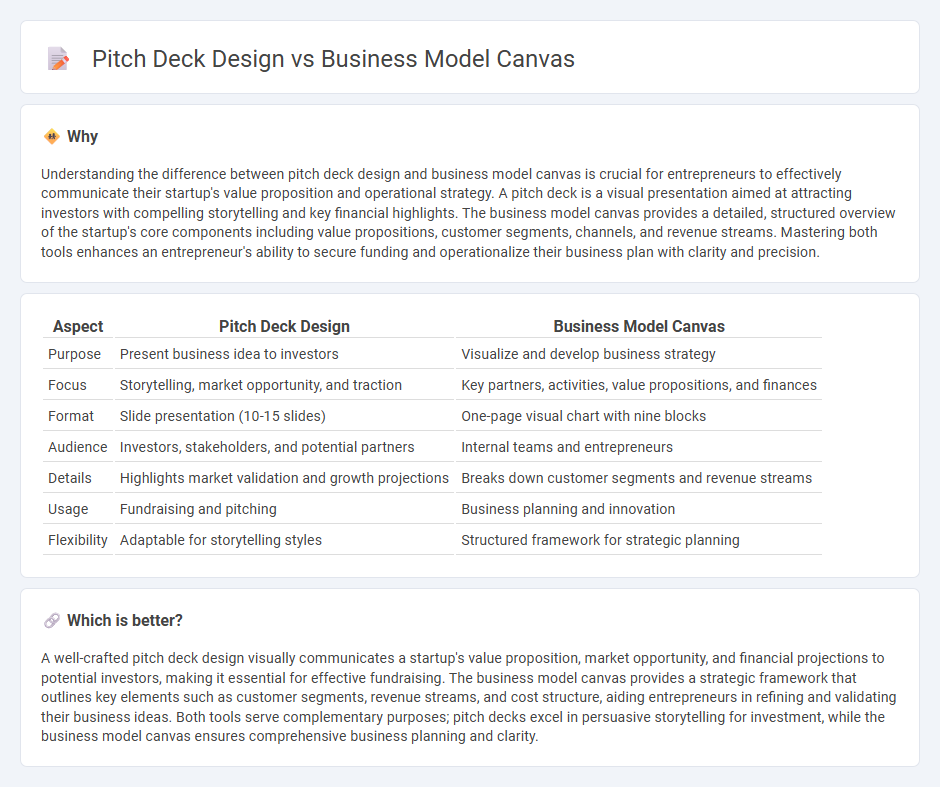
Pitch deck design focuses on visually presenting key business ideas to attract investors, emphasizing clarity, aesthetics, and persuasive storytelling. Business model canvas offers a strategic framework to map out essential components like value proposition, customer segments, and revenue streams, providing a comprehensive overview of the business structure. Explore more insights on how to effectively leverage both tools for entrepreneurial success.
Why it is important
Understanding the difference between pitch deck design and business model canvas is crucial for entrepreneurs to effectively communicate their startup's value proposition and operational strategy. A pitch deck is a visual presentation aimed at attracting investors with compelling storytelling and key financial highlights. The business model canvas provides a detailed, structured overview of the startup's core components including value propositions, customer segments, channels, and revenue streams. Mastering both tools enhances an entrepreneur's ability to secure funding and operationalize their business plan with clarity and precision.
Comparison Table
| Aspect | Pitch Deck Design | Business Model Canvas |
|---|---|---|
| Purpose | Present business idea to investors | Visualize and develop business strategy |
| Focus | Storytelling, market opportunity, and traction | Key partners, activities, value propositions, and finances |
| Format | Slide presentation (10-15 slides) | One-page visual chart with nine blocks |
| Audience | Investors, stakeholders, and potential partners | Internal teams and entrepreneurs |
| Details | Highlights market validation and growth projections | Breaks down customer segments and revenue streams |
| Usage | Fundraising and pitching | Business planning and innovation |
| Flexibility | Adaptable for storytelling styles | Structured framework for strategic planning |
Which is better?
A well-crafted pitch deck design visually communicates a startup's value proposition, market opportunity, and financial projections to potential investors, making it essential for effective fundraising. The business model canvas provides a strategic framework that outlines key elements such as customer segments, revenue streams, and cost structure, aiding entrepreneurs in refining and validating their business ideas. Both tools serve complementary purposes; pitch decks excel in persuasive storytelling for investment, while the business model canvas ensures comprehensive business planning and clarity.
Connection
Pitch deck design and business model canvas are interconnected tools that visually articulate a startup's value proposition, target customers, revenue streams, and cost structure. The business model canvas provides a structured outline that informs the content and flow of a pitch deck, ensuring clarity and strategic alignment for investors. Effective integration of these frameworks enhances communication by translating complex business strategies into compelling narratives and visuals.
Key Terms
**Business Model Canvas:**
The Business Model Canvas provides a structured framework for visualizing key components such as value propositions, customer segments, revenue streams, and key activities, enabling strategic clarity and operational alignment. It serves as a foundational tool for entrepreneurs to map out their business logic and test hypotheses before investing in detailed pitch deck design. Explore the nuances of the Business Model Canvas to enhance your startup's strategic planning and investor communication.
Value Proposition
The business model canvas centers on defining the Value Proposition by detailing how a product or service addresses specific customer needs and creates unique value within the market framework. In contrast, pitch deck design emphasizes visually communicating the Value Proposition compellingly to attract investors, highlighting benefits and differentiators succinctly. Explore further to master aligning Value Proposition effectively across both tools.
Customer Segments
Customer Segments in a Business Model Canvas define the specific groups of people or organizations a company aims to serve, providing a clear framework for tailored value propositions. In contrast, a Pitch Deck design highlights Customer Segments to quickly communicate the target market's size and potential impact, often using visuals and concise data for investor appeal. Explore effective strategies to optimize Customer Segments for both tools to enhance business clarity and funding success.
Source and External Links
Business Model Canvas: Explained with Examples - Creately - The Business Model Canvas is a one-page strategic tool that breaks down a business idea into nine key elements, focusing on customer-facing and internal operations and highlighting the value exchange between the business and customers.
Free download Business model canvas - Created by Alexander Osterwalder, the Business Model Canvas is a structured tool to understand a business model focusing on customer segments, value propositions, revenue streams, channels, customer relationships, key activities, and societal/environmental benefits.
Create a Business Model Canvas Online | Canva - The Business Model Canvas is a visual framework that helps entrepreneurs assess business viability by identifying customers, activities, costs, and revenue streams in a one-page document, with customizable templates to facilitate collaboration and presentation.
 dowidth.com
dowidth.com